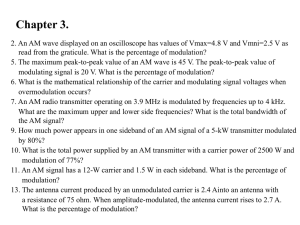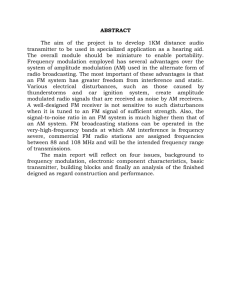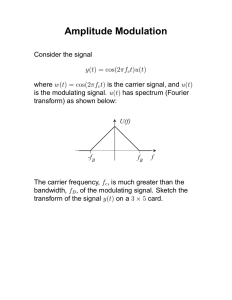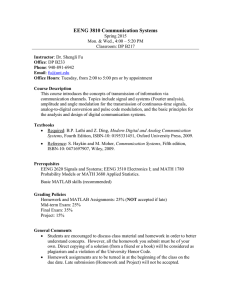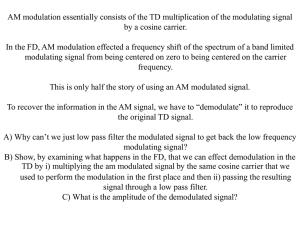AMPLITUDE MODULATION(AM) - Universiti Teknologi Malaysia
advertisement
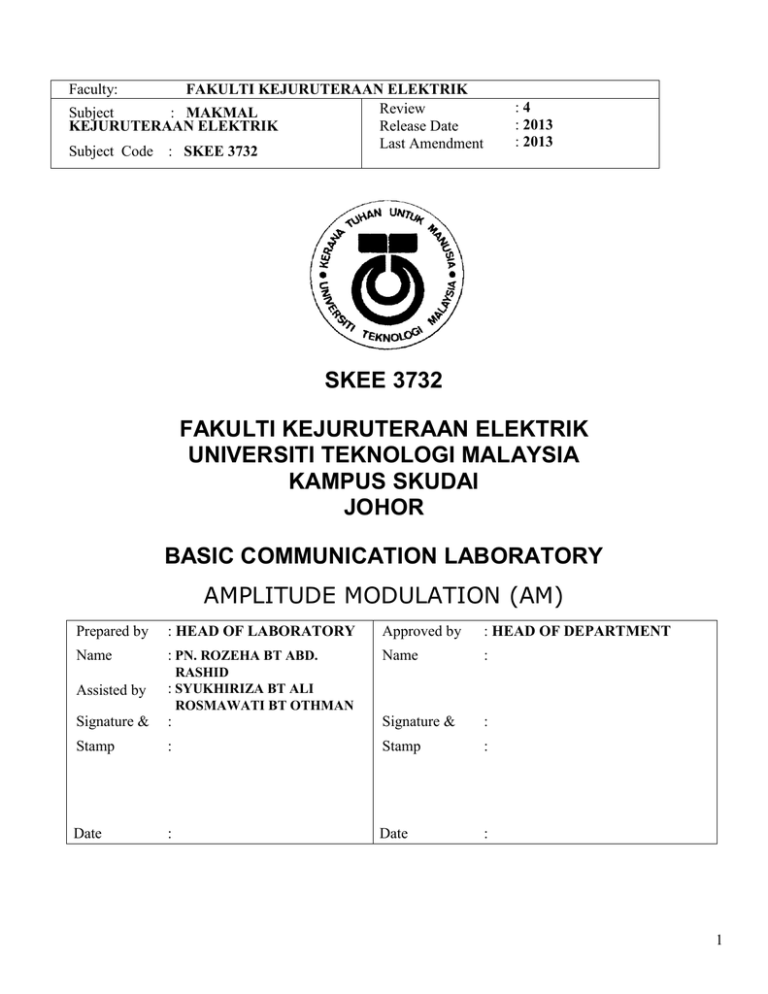
Faculty: FAKULTI KEJURUTERAAN ELEKTRIK Review Subject : MAKMAL KEJURUTERAAN ELEKTRIK Release Date Last Amendment Subject Code : SKEE 3732 :4 : 2013 : 2013 SKEE 3732 FAKULTI KEJURUTERAAN ELEKTRIK UNIVERSITI TEKNOLOGI MALAYSIA KAMPUS SKUDAI JOHOR BASIC COMMUNICATION LABORATORY AMPLITUDE MODULATION (AM) Prepared by : HEAD OF LABORATORY Approved by : HEAD OF DEPARTMENT Name : PN. ROZEHA BT ABD. Name : Assisted by RASHID : : SYUKHIRIZA BT ALI ROSMAWATI BT OTHMAN Signature & : Signature & : Stamp : Stamp : Date : Date : 1 1- OBJECTIVES a) To understand the concept of linear modulation techniques in terms of time and frequency domain representations. b) To examine the main parameters of amplitude modulated signals. c) To introduce the application of frequency shift property of Fourier Transform in amplitude modulated signals. 2- MODULATION Modulation is a process of translating information signal from low band frequency to high band frequency that suits the transmission medium. The inputs to the modulator are carrier and information (modulating) signals while the output is called the modulated signal. Modulating or information signal is usually of low frequency, so it cannot travel far. It needs a carrier signal of higher frequency for long distance destination. Figure 2.1 shows a basic block diagram of a modulator. Information signal, m(t) Modulator Modulated signal Carrier signal, vc(t) where carrier frequency, fc >> information/modulating frequency, fm Figure 2.1: Basic Block Diagram of A Modulator Figure 2.2 illustrates the use of Fourier Transform where the modulating/information signal and the carrier are simply multiplied together. Assuming a sinewave information signal for simplicity, the result will be Amplitude Modulated-Double Sideband Suppressed Carrier (AM-DSBSC) whose modulation process translates the Fourier Transform M(ω) of m(t) up to the frequency range from fc–fm to fc+fm (and the negative frequency range from –fc- fm to –fc+fm). m(t) vDSBSC vc(t) Figure 2.2 AM-DSBSC modulation 2 2-1 CONVENTIONAL/ FULL AMPLITUDE MODULATION (AM) Conventional or Full AM can be understood as the classic AM technique for transmitting messages as it is still used today for radio broadcasting on short, medium and long waves. It involves the transmission of the carrier and the double sideband signals. Amplitude Modulation (AM) refers to the modulation technique where the carrier’s amplitude is varied in accordance to the modulating signal’s amplitude. The major advantage of this modulation technique is in the simple demodulation process. vFull AM (t ) ( Ec mt ) cos ct In addition to this technique, there are a number of other techniques which differ within the spectrum of AM techniques. A disadvantage of conventional AM is that a carrier is transmitted which does not represent a message. In addition, two sidebands are transmitted with the same information. The aim of the further developed AM is to save bandwidth or transmitter power or to utilize it more economically. Figure 2.3 lists the different types of amplitude modulation. The line diagram and frequency spectrum are illustrated under the relevant terms. The frequency band(s) to be transmitted are often represented graphically as discrete band(s) or triangles for periodic and non-periodic signals, respectively. In the spectrum of the AM double sideband modulation, the upper sideband appears in normal position, the lower sideband in inverted position. The top diagram shows the conventional AM of which the frequency spectrum is composed of the carrier frequency, fc, upper sideband, fc+fm and lower side band, fc-fm. Conventional Amplitude Modulation, AM LSB = Lower Side Band m = modulation index USB = Upper Side Band A = carrier amplitude fc = Carrier Frequency fm = Information Frequency A mA/2 AM- DSB (AM – Double Side Band) or SCAM (Suppressed Carrier AM) 3 SSB (Single Side Band Modulation) Figure 2.3 Different types of amplitude modulation 2-2 THE MODULATION FACTOR, m The change in the carrier amplitude is proportional to the change in the modulation signal amplitude. The ratio of this change to the unmodulated carrier amplitude is known as the modulation factor, m. It is often specified as a percentage. As high a modulation percentage as possible is aimed at in a transmission system. The highest value of m under ideal scenario is m = 1. m E max E min E max E min where E max = 2( Ec Em ) dan E min = 2( Ec Em ) m = modulation factor Em Emin EC Emax = modulating amplitude = unmodulated carrier amplitude The method of measuring the modulation factor from the oscilloscope is of a very theoretical nature because a sinewave voltage with constant amplitude is very rarely transmitted. Measuring with the modulation trapezium allows a very simple and quick check of the modulation factor, even for speech and music signals. The oscilloscope is switched to XY-mode for this; the information signal is applied in X direction, the AM in Y direction. 4 References: 1. Rozeha A. Rashid & et al., Prinsip Kejuruteraan Telekomunikasi, Penerbit UTM 2007 2. Abu Sahmah & et al., Principles of Communication, Pearson 2011. 5 INSTRUMENT REQUIRED 1) 2) 3) Modulation Board Type 4280 Demodulation Board Type 4281 Pico Scope / Oscilloscope / Spectrum Analyzer Read all procedures before you do this experiment. If you have any problems, get the lab instructor/supervisor to help you. AM PROCEDURE 1. The sources for the input signals; the carrier, modulating and the DC signals, are shown on the left side of the figure. Set the VDC to +1V. Set the carrier level, Ec to maximum. Select a frequency for the modulating signal, m(t). Record your observations. 2. Set the modulating amplitude, Em to zero. Observe and record the signal at point 1 in the respective time and frequency domain representations as well as its trapezoid form. 3. Increase the modulating amplitude, Em such that the modulation index, m is less than 1. Calculate m. Record your observations as in step 2. 4. Increase the Em until it reaches 100% modulation. Observe and record the observations as before. Now monitor the output signal at point 2. Do and record the comparison between the signal outputs at point 1 and point 2. 5. Observe and record what happen if Em is increased further. 6. Switch back to m =1. Observe the signal in frequency domain. Adjust VDC until the carrier level is suppressed. This is a Double Sideband Suppressed Carrier (DSBSC), which is an application of frequency shift property of Fourier Transform. Compare this signal with the signal at m =1. Discussion and Analysis a) Based on your experiment, state the frequencies of the carrier and the modulating signals. What happens when a DC voltage is introduced alongside the modulating signal, m(t)? b) From the output at point 1, what do you think is the function of Block A? c) For step 2, what can you conclude on the modulation state of the signal at point 1? d) What is the amplitude of the two sidebands relative to the carrier for 50% modulation with a sinusoidal wave? e) How are different amplitudes of the message/modulating signal represented in the modulated signal? 6 f) From the comparison of signals in step 4, in your opinion, what is the function of Block B? Give a brief explanation. g) Based on your observation in step 5, what happens to the positive and negative envelopes when over-modulation occurs? How would you recognise over-modulation on the spectrum analyzer display? h) Write down your conclusion on the comparison of signals in step 6. In your opinion, can a DSBSC signal being demodulated using the function of Block B? i) Filtering is another application of frequency shift property of Fourier Transform. From your understanding of filtering and the functions available on the modulation board, please determine how to transform the DSBSC signal of step 6 into a Single Sideband Suppressed Carrier (SSBSC) signal. Show your result to justify your finding. FOR LONG REPORT 1. Give examples of commercial applications of AM 2. Please include discussion on different types of AM in terms of system and power efficiencies. 3. Include a simulation using MATLAB of one type of AM (Full AM/DSBSC/SSBSC) and compare with the experimental result. 7
